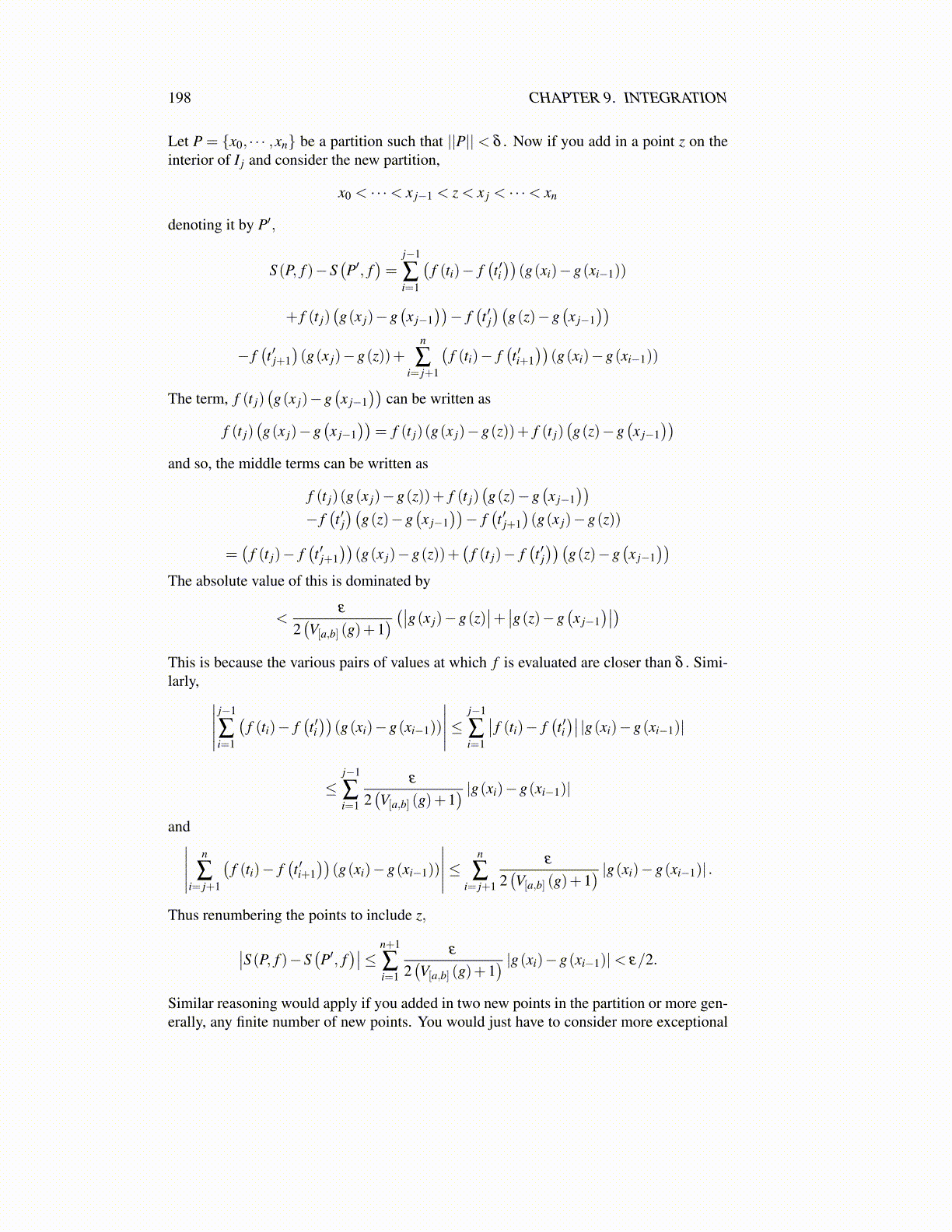
198 CHAPTER 9. INTEGRATION
In the second sum above, for each i ∈ IC, [xi−1,xi] must be contained in[x∗k−1,x
∗k
]for
some k because there are no points of Q in [xi−1,xi]. Therefore, the sum of the terms forwhich [xi−1,xi] is contained in
[x∗k−1,x
∗k
]is no larger than the term in the sum which equals
U ( f ,Q)−L( f ,Q) . (Note how it is important that g be increasing.) Therefore, the secondsum is no larger than U ( f ,Q)−L( f ,Q) and
U ( f ,P)−L( f ,P)≤∑i∈I
(Mi−mi)(g(xi)−g(xi−1))+U ( f ,Q)−L( f ,Q) (9.2)
Now consider the first sum. Since | f (x)| ≤M,(Mi−mi)(g(xi)−g(xi−1)) ≤ 2M∥Pg∥ andso, since each of these intervals [xi−1,xi] for i ∈ I contains at least one point of Q, there canbe no more than n of these. Hence the first sum is dominated by 2Mn
∥∥Pg∥∥ .
The following theorem applies to the case where f ,g are real valued and g is continuous.This includes the case of greatest interest which is g(x) = x in which one is considering theRiemann integral. Historically, it shows that Riemann integrability is equivalent to Darbouxintegrability. The latter consists of definining the integral in terms of upper and lower sums,the integral being the unique number between all upper sums and all lower sums. Darbouxshowed that his integral was equivalent to the Riemann integral which has been describedabove by using the special case g(x) = x which is a special case of the following theorem.Thus the following theorem is essentially due to Darboux.
Theorem 9.3.10 Let g be an increasing continuous function and let f be real val-ued and | f (x)| ≤M for all x. Then f ∈ R([a,b] ,g) if and only if for each ε > 0, there existsa partition Q such that
U ( f ,Q)−L( f ,Q)< ε (9.3)
Proof: ⇐ Let ε > 0 be given and let Q be a partition such that U ( f ,Q)−L( f ,Q) <ε/3. Say Q =
{x∗0, · · · ,x∗n
}. Now there exists δ such that if each xi − xi−1 < δ , then
|g(xi)−g(xi−1)| < ε
6Mn . Thus∥∥Pg∥∥ in the above lemma is no larger than ε
6Mn . Therefore,from Lemma 9.3.9 above, if ∥P∥< δ , then
|U ( f ,P)−L( f ,P)| ≤ 2Mn∥∥Pg∥∥+ |U ( f ,Q)−L( f ,Q)| ≤ ε
3+
ε
3< ε.
It follows, since ε is arbitrary that there exists δ m→ 0 such that the diameter of Sm definedby
Sm ≡ ∪
{∑P
f (tk)(g(xk)−g(xk−1)) : ∥P∥ ≤ δ m
}converges to 0. Thus there is a unique I in the intersection of these Sm and by definition,this is the integral.⇒ Suppose f ∈ R([a,b] ,g) . Then given ε > 0, there is δ > 0 and I such that if ∥P∥< δ∣∣∣∣∣∑P f (tk)(g(xk)−g(xk−1))− I
∣∣∣∣∣< ε
3
Pick such a partition P = a = x0 < · · · < xn = b. Here tk ∈ [xk−1,xk] is arbitrary. Picktk,sk ∈ [xk−1,xk] such that
f (tk)+ε
6(g(b)−g(a)+1)n> Mk, f (sk)−
ε
6(g(b)−g(a)+1)n< mk